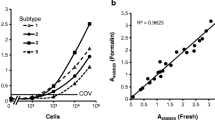Abstract
Blastocystis spp. refer to a group of prevalent enteric protists found in humans and animals. Detection of Blastocystis spp. in fecal samples is often performed by clinicians with direct microscopy, which provides low sensitivity, or with culture and polymerase chain reaction testing, a method which is problematic when used with formalin-preserved stool samples. Prior study of Blastocystis and other enteric protists suggests that immunofluorescence antibody (IFA) stain could provide sensitivity and compatibility with formalin, but no information is available on the longevity of Blastocystis sp.’s surface antigens in formalin. We collected fecal samples from animals at a country fair held in the summer of 2009 in Oregon, USA. Samples were tested for the presence of Blastocystis infection using an IFA stain shortly after collection, and again after 1 year, with samples stored refrigerated at 4–8 °C. Most samples collected from steer, pigs, and goats were found to be Blastocystis positive. All fecal samples that were Blastocystis positive initially remained positive after 1 year. Blastocystis-negative samples remained negative. Minimal degradation was observed in stained slides. Blastocystis surface antigens detected by a polyclonal stain remained stable in formalin for a period of at least 1 year.


Similar content being viewed by others
References
Abe N, Nagoshi M, Takami K, Sawano Y, Yoshikawa H (2002) A survey of Blastocystis sp. in livestock, pets, and zoo animals in Japan. Vet Parasitol 106(3):203–212
Amin OM (2002) Seasonal prevalence of intestinal parasites in the United States during 2000. AmJTrop Med Hyg 66(6):799–803
Dogruman-Al F et al (2010) Comparison of methods for detection of Blastocystis infection in routinely submitted stool samples, and also in IBS/IBD patients in Ankara, Turkey. PLoS One 5(11):e15484. doi:10.1371/journal.pone.0015484
Garcia LS, Shimizu RY (1997) Evaluation of nine immunoassay kits (enzyme immunoassay and direct fluorescence) for detection of Giardia lamblia and Cryptosporidium parvum in human fecal specimens. J Clin Microbiol 35(6):1526–1529
Jones MS, Whipps CM, Ganac RD, Hudson NR, Boorom K (2009) Association of Blastocystis subtype 3 and 1 with patients from an Oregon community presenting with chronic gastrointestinal illness. Parasitol Res 104(2):341–345. doi:10.1007/s00436-008-1198-7
Jongwutiwes S, Tiangtip R, Yentakarm S, Chantachum N (2002) Simple method for long-term copro-preservation of Cryptosporidium oocysts for morphometric and molecular analysis. Trop Med Int Health 7(3):257–264
Kuhnert-Paul Y, Bangoura B, Dittmar K, Daugschies A, Schmaschke R (2012) Cryptosporidiosis: comparison of three diagnostic methods and effects of storage temperature on detectability of cryptosporidia in cattle faeces. Parasitol Res 111(1):165–171. doi:10.1007/s00436-011-2813-6
Lagace-Wiens PR, VanCaeseele PG, Koschik C (2006) Dientamoeba fragilis: an emerging role in intestinal disease. CMAJ 175(5):468–469. doi:10.1503/cmaj.060265
Morimoto N, Komatsu C, Nishida M, Sugiura T (2001) Detection of Giardia lamblia cysts in non-fixed long-term stored human feces by direct immunofluorescence assay. Jpn J Infect Dis 54(2):72–74
Parkar U et al (2010) Molecular characterization of Blastocystis isolates from zoo animals and their animal-keepers. Vet Parasitol 169(1–2):8–17. doi:10.1016/j.vetpar.2009.12.032
Rosenblatt JE, Sloan LM (1993) Evaluation of an enzyme-linked immunosorbent assay for detection of Cryptosporidium spp. in stool specimens. J Clin Microbiol 31(6):1468–1471
Stensvold CR et al (2009) Blastocystis: unravelling potential risk factors and clinical significance of a common but neglected parasite. Epidemiol Infect 137(11):1655–1663. doi:10.1017/S0950268809002672
Stibbs HH, Samadpour M, Manning JF (1988) Enzyme immunoassay for detection of Giardia lamblia cyst antigens in formalin-fixed and unfixed human stool. J Clin Microbiol 26(9):1665–1669
Yakoob J et al (2010) Irritable bowel syndrome: is it associated with genotypes of Blastocystis hominis. Parasitol Res 106(5):1033–1038. doi:10.1007/s00436-010-1761-x
Zierdt CH (1991) Blastocystis hominis—past and future. Clin Microbiol Rev 4(1):61–79
Author information
Authors and Affiliations
Corresponding author
Rights and permissions
About this article
Cite this article
Gould, R., Boorom, K. Blastocystis surface antigen is stable in chemically preserved stool samples for at least 1 year. Parasitol Res 112, 2469–2471 (2013). https://doi.org/10.1007/s00436-013-3411-6
Received:
Accepted:
Published:
Issue Date:
DOI: https://doi.org/10.1007/s00436-013-3411-6




